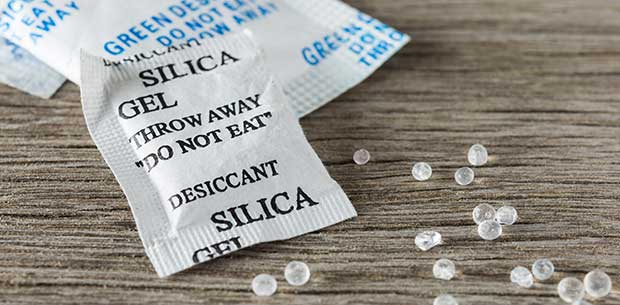

If the dose is large enough to cause poisoning, severe metabolic acidosis, shock and hepatic toxicity can develop one to five days after the exposure.

In fact, vomiting is such a common finding that if a dog does not vomit, it’s probable that a toxic dose was not ingested. After ingestion, vomiting (with or without blood) is one of the first signs of poisoning. > Why is it labeled “do not eat”? Elemental iron can cause severe poisoning, even in the small amounts contained in one oxygen absorber packet.2 It also irritates the gastrointestinal tract and has direct corrosive effects. This material is magnetic, which allows for quick differentiation between packets containing iron and those containing silica gel or charcoal. If the oxygen absorber is broken open, dark brown or rust-colored material is visible. This prevents oxidization (rancidity) of the food and preserves freshness.1 Oxygen absorber packets are typically about 1 inch by 1 inch and are often found in packages of beef jerky, pepperoni, dried fruits, dog jerky treats, etc. > What is it? Elemental iron granules are placed in small packets called oxygen absorbers and added to bags of prepared or dehydrated food to absorb excess oxygen. You’d need to administer the contents of thousands of canisters before achieving any therapeutic benefit! Best to stick with good old activated charcoal. In case you were hoping to save some money by saving the charcoal in these canisters for use in the clinic, think again. However, no true toxicity risk exists from the charcoal or external canister. > Is it a threat to dogs? The cylinder can cause a foreign body obstruction in small dogs and can damage the oral cavity when chewed. > Why is it labeled “do not eat”? The charcoal carries a “do not eat” label because it’s not intended for consumption. These granules are not magnetic (as compared to iron). If the cylinders are broken open, the small black granules are visible. > What is it? A specific type of prepared charcoal (similar to activated charcoal used in veterinary hospitals) is found in white plastic cylinders inside bags of prepared foodstuffs like dog treats, chews and jerky. The beads do not enlarge in the stomach, and the exterior packaging is usually soft and presents little risk of injury of obstruction. > Is it a threat to dogs? No true toxicity risk exists from exposure to silica gel packets. If a dye is present, the silica gel will no longer be clear or white, but instead bright orange, blue, pink or green. Some silica products are mixed with a moisture indicator, these indicators may be toxic in large doses. Fortunately, our furry friends rarely encounter silica dust. Employees in mines or factories chronically exposed to or inhaling silica can develop a debilitating disease called silicosis. The dust from the processing and creation of silica is irritating to the skin, respiratory tract and gastrointestinal tract. > Why is it labeled “do not eat”? The packet carries a “do not eat” label because it’s not intended for consumption. Silica gel packets are usually 1 inch by 2 inches and contain multiple small white, clear or opaque beads inside. > What is it? Silica is a hard, porous, synthetic gel placed in products to control humidity and prevent degradation. Here are the three common ingredients and how they affect canines: Fortunately, most are harmless and require minimal or no veterinary care. The purpose of these little packets is to either reduce moisture in the packaging or to absorb oxygen. Plenty of packages for dried food, medications and even shoes contain small packets placed there by the manufacturer to maintain freshness.


 0 kommentar(er)
0 kommentar(er)
